Draft Sectoral Marine Plans for Offshore Renewable Energy in Scottish Waters - Environmental Report Appendix B: Baseline Information
Appendix B to the SEA Environmental Report of the Draft Sectoral Marine Plans for Offshore Renewable Energy in Scottish Waters.
This appendix contains Baseline Information.
1.2 Biodiversity, Flora and Fauna
Key Issues Summary
- General pressures on biodiversity, flora and fauna include climate change, development, dredging, pollution, marine litter, fishing, invasive non-native species, other coastal and marine users ( e.g. oil and gas, aquaculture, recreation), and the vulnerability of marine and coastal species and habitats to these pressures.
- Species and habitats considered to be vulnerable to these pressures include shoreline and tidal habitats, coral reefs and mudflats, each of which support a wide range of species such as snails, clams, mussels and oysters, bony fish, shellfish, cetaceans ( i.e. whales, dolphins and porpoises), elasmobranchs ( i.e. sharks, skates and rays), seals, otters and many types of birds.
- The importance of Scotland's marine and coastal areas is demonstrated through the designation of and value off many sites of importance to nature conservation.
- There is a high degree of uncertainty in many aspects of marine biodiversity, and the potential for working towards filling data gaps has been identified.
National Marine Baseline
Habitats
1.2.1 Six broad habitats are found in Scottish waters: intertidal rock, intertidal sediment, subtidal rock, shallow subtidal sediments, shelf subtidal sediments and deep-sea habitats. The spatial distribution of these habitats is displayed in Figure B1.2.1.
Figure B1.2.1: Modelled Distribution of Habitats in Scottish Waters [1]
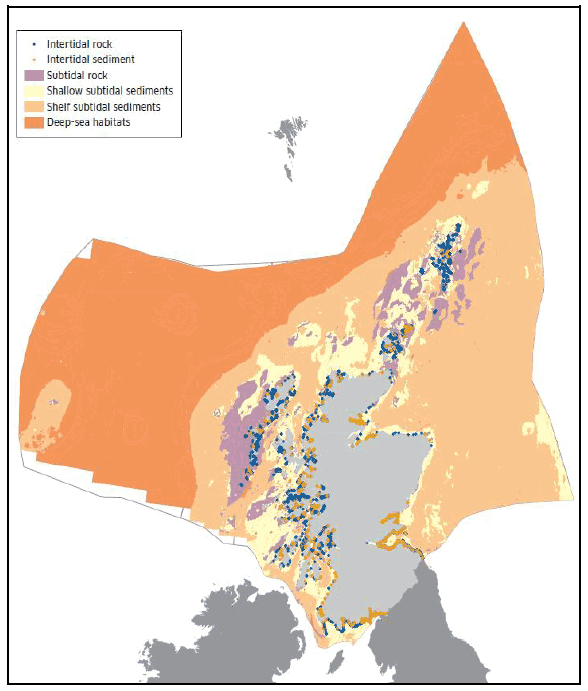
1.2.2 Intertidal rock represents around 48% of Scotland's coastline. These habitats are located at the shoreline, comprise bedrock, boulders and cobble substrate, and are characterised by wave exposure, salinity and tides. The upper regions of many rocky shores are relatively species poor, especially on exposed coasts, but towards the bottom of the shore, species richness can be very high. They host many important ecosystems ( e.g. seaweed communities) and are important resting and foraging places for many animals ( e.g. grey seals, otters and various wading birds) [2] .
1.2.3 Intertidal sedimentary habitats make up around 50% of Scotland's coastline, and comprise mobile shingle, gravel, sand, mud or combinations of these, and vascular plant communities in the upper shores that form saltmarshes. These habitats support communities of animals that are typically species poor but highly productive ( e.g. burrowing worms and bivalve molluscs) [3] . Many such habitats are designated as Special Protection Areas ( SPAs) and are important for overwintering birds.
1.2.4 Subtidal rock habitats comprise bedrock, boulders and cobbles occurring below the water mark. They range in depth, and as such, their make-up is strongly affected by the availability of light. Shallow areas are typically dominated by seaweed communities while the communities in deeper areas comprise exclusively of marine animals [4] .
1.2.5 Shallow and shelf subtidal sediment habitats cover an extensive area of the seabed, and comprise shingle, gravel, sand and mud substrates. However, these habitats can also include inshore sediments such as lagoons and maerl beds, and often support diverse marine communities in these areas. They extend to depths below the effects of wave patterns (around 50 - 70m below sea level) with shelf sediments extending to 200m depth [5] .
1.2.6 Deep sea habitats occur beyond the continental shelf break at depths typically greater than around 200m below sea level. Knowledge of these habitats is currently limited but is increasing, and they are found almost entirely to the north and west of Scotland, and comprise predominantly deep sea sediments, with occurrences of cold water coral reefs, coral carbonate mounds, submarine canyons and sea mounts [6] .
1.2.7 The term benthic marine habitats is used to describe all biological communities associated with the sea floor, from the top of the intertidal zone and inner reaches of estuaries to the deep sea. The composition of the benthos varies widely within Scotland's waters, and it plays a key role in supporting the marine ecosystem. The benthos and contains a wide range of flora and fauna species whose importance has been recognised by their inclusion as priority marine features ( PMFs) ( e.g. sea grass beds, tidal-swept algal communities, blue mussel beds) [7] .
Designations
1.2.8 Designations at a European level protect internationally important and threatened habitats and species, and are called Natura sites. These sites are made up of Special Protection Areas ( SPA), designated for threatened or vulnerable bird species listed in Annex I of the Birds Directive, and Special Areas of Conservation ( SAC) selected for a number of habitats and species, both terrestrial and marine, which are listed in the Habitats Directive.
Special Areas of Conservation ( SACs)
1.2.9 Scotland has a number of marine and coastal protected sites. There are 40 coastal and offshore marine Special Areas of Conservation ( SACs), one possible ( pSAC) and six candidate areas ( cSACs) [8] covering habitat types such as sandbanks, sea caves, estuaries, mudflats, coastal lagoons, shallow inlets and bays and reefs. Furthermore they include several species including otter, bottlenose dolphin, grey seal, and harbour seal, amongst others [9] . The pSAC and cSACs in the Scottish offshore region were submitted in October 2012, and comprise Sound of Barra, Anton Dohrn Seamount, East Rockall Bank, Hatton Bank, Pobie Bank Reef and Solan Bank Reef.
1.2.10 As of January 2011, of the 129 habitat features identified on designated sites in Scotland, 94 of the 96 assessed were considered to be in favourable condition. In terms of fauna features, some 86% of mammal features and 84% of waterfowl features assessed were considered to be favourable. However, just under half of seabirds features assessed were considered in an unfavourable or unfavourable-recovering condition [10] .
Figure B1.2.2: Marine Special Areas of Conservation ( SACs)
SACs, SACs Offshore and SAC's with marine components
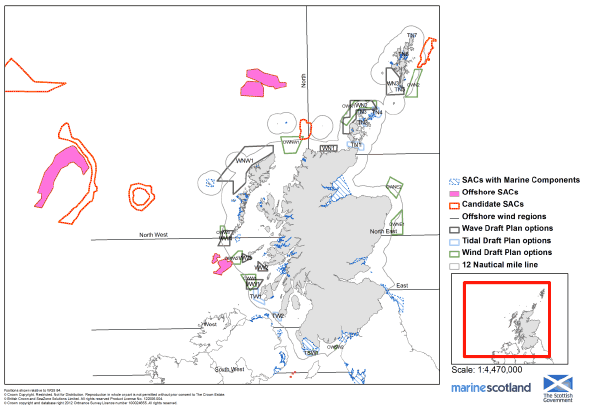
1.2.11 A number of important rivers have also been designated due to their coastal and marine relevance, particularly over the presence of mobile species such as Atlantic salmon. Some 17 SACs have been designated due to their importance for Atlantic salmon, either as a qualifying feature or as the primary reason for selection, located largely in the East, North East and North regions of the Scottish mainland [11] . Of these, two are considered to be favourable-maintained (River Tay and River Dee), with the remaining 15 classified as having unfavourable-recovering status [12] . Many of Scottish rivers and estuaries also support important populations of Sea trout, also listed as a Priority Marine Feature ( PMF).
Figure B1.2.3: Atlantic Salmon Special Areas of Conservation in Scotland
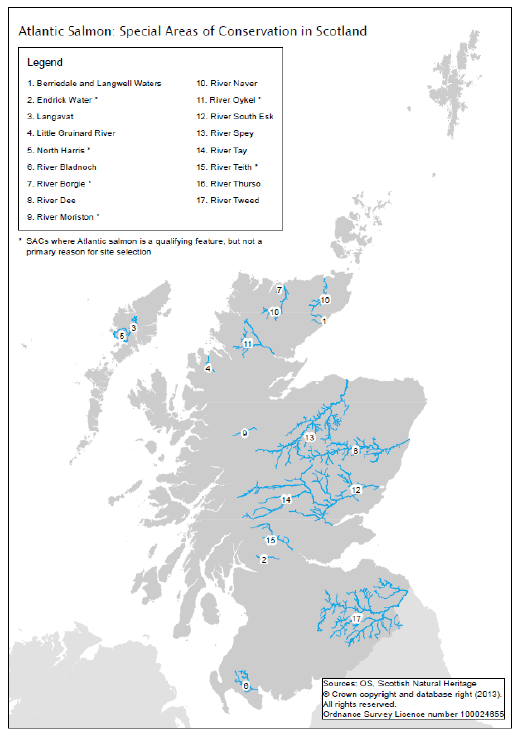
Special Protection Areas ( SPAs)
1.2.12 Scotland's marine environment includes many areas that are of international importance for bird species ( i.e. seabirds, waders, ducks, geese and swans). Scotland's Environment Web identifies 58 Special Protection Areas ( SPAs) designated for their importance to birds, that have marine or coastal components [13] . Although Scotland's coastal SPAs support large colonies of seabirds, there is ongoing concern about the continuing decline in the overall seabird populations, particularly in the Northern and Western Isles [14] . SPAs relevant to the plan option areas are discussed further in the appropriate sections of the regional baseline.
Figure B1.2.4: Marine Special Protection Areas ( SPAs)
SPAs with marine components
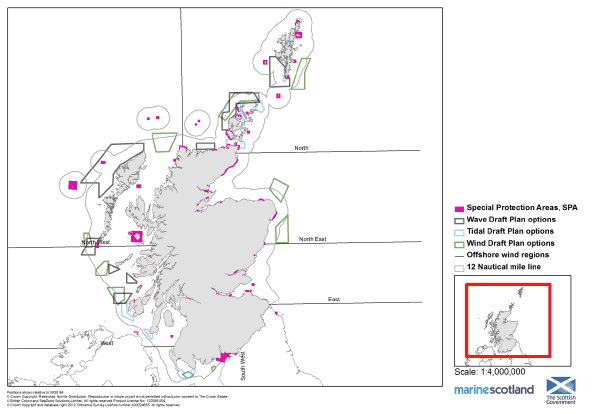
1.2.13 The Joint Nature Conservation Committee ( JNCC) have started a process to identify possible marine SPAs using existing and targeted survey data, and development of a series of maps showing several Areas of Search (AoS). These areas do not represent formal designations but rather provide additional information for identifying important aggregations of waterbirds in Scotland and across the UK.
1.2.14 The AoS identified in Scotland largely complement the existing network of SPAs, and are located around the Scottish coastline and amongst the Northern and Western Isles, and include important coastal areas such as the Firth of Forth, Moray Firth, Solway Firth and Firth of Tay, amongst others [15] .
Figure B1.2.5: Areas of Search for Inshore Aggregations of Waterbirds Outwith the Breeding Season
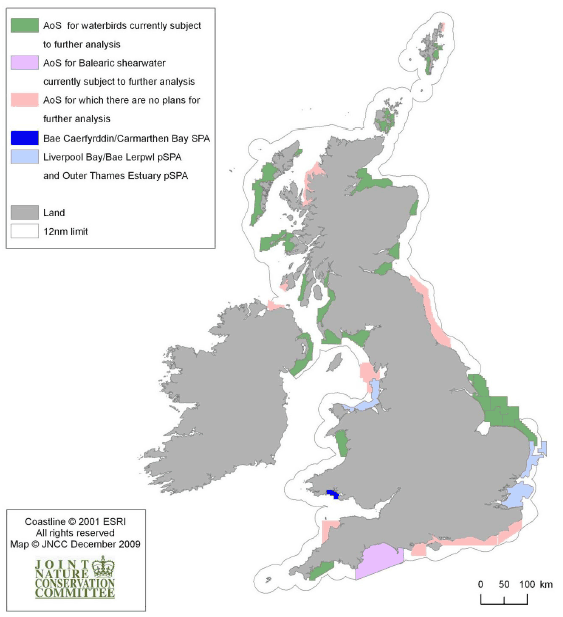
1.2.15 The JNCC have also identified a further five areas of important seabird concentrations, including the areas near the Firth of Forth and Firth of Tay; between Golspie and Helmsdale; east of the Pentland Firth; to the west of Shetland; and to the north west of Lewis [16] . The AoS identified by JNCC do not represent formal designations but provide additional information for identifying important aggregations of seabirds in Scotland.
Figure B1.2.6: Important Seabird Concentrations Being Considered in an SPA Context
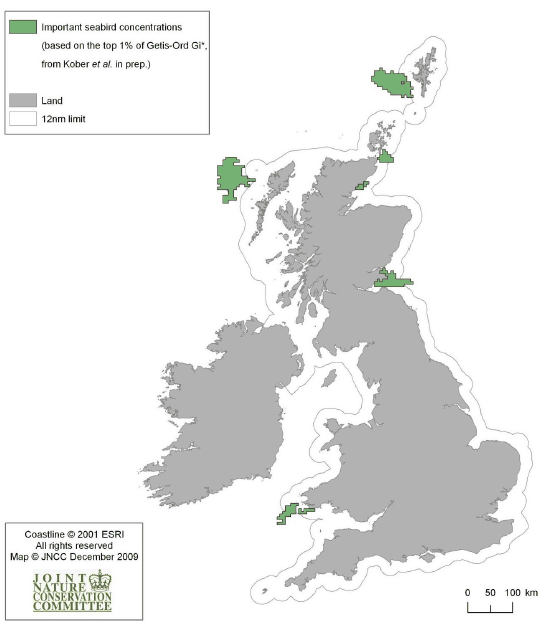
Priority Marine Features ( PMFs)
1.2.16 Many marine mammal species, including grey and harbour seals, and cetaceans ( i.e. Common dolphin, Bottlenose dolphin, White-beaked dolphin, Risso's dolphin, Harbour porpoise, Minke whale, Killer whale, Sperm whale, Fin whale, Northern bottlenose whale and Sowerby's beaked whale) are also recognised as PMFs, as are several species of elasmobranchs ( i.e. Basking shark, Blue shark, Porbeagle shark, Leafscale gulper shark, Spiny dogfish, Portugese dogfish, Common skate and Sandy rays) [17] . Furthermore, Scottish waters contain several species of elasmobranchs that are not PMFs but are nonetheless important to marine biodiversity, including skates and rays ( e.g. Starry skate, Shagreen ray, Thornback ray) and sharks ( e.g. Tope, Starry smoothhound, Nursehound) [18] .
1.2.17 Marine plant life is key to the health of our seas and the species it supports, with Scotland's seas including a wide range of seaweeds, phytoplankton and sea grasses closer to the coast, many of which have been recognised as PMFs ( e.g. Sea grass beds; Blue, Horse and Flame shell mussel beds; Native oysters, European spiny lobster) [19] . Some species, including those with coastal interests such as the Freshwater pearl mussel, have seen significant population declines to the point that these species are now rare in Europe, giving extra significance to UK and Scottish populations [20] . In many cases, this significance has been demonstrated through the designation of SACs for the conservation of these species.
Marine Protected Areas ( MPAs)
1.2.18 Scottish Ministers are committed to setting up a national network of ecologically coherent Marine Protected Areas ( MPAs) to protect features of conservation importance in both inshore and offshore waters adjacent to Scotland. This will provide protection for features beyond those which are of European significance.
1.2.19 The Marine (Scotland) Act 2010 and the Marine and Coastal Access Act 2009 both contain new powers to designate Marine Protected Areas ( MPAs) to protect features of conservation importance in both inshore and offshore waters adjacent to Scotland, and that a network of MPAs in UK seas is created to protect biodiversity and geodiversity. This network will contribute to a range of measures to manage and protect our seas for current and future generations, while also contributing to our agreement with international partners to create an ecologically coherent network of well-managed MPAs in the North East Atlantic. The Sectoral Plans for Wind, Wave and Tidal energy will take cognisance of these MPA proposals, and a linked consultation on the MPA proposals will be published alongside this consultation.
Figure B1.2.7: Marine Protected Area Proposals [21]
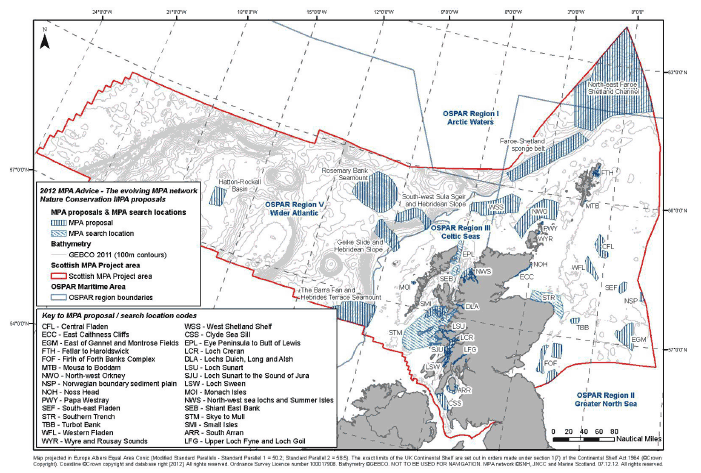
Sites of Special Scientific Interest ( SSSI)
1.2.20 Sites of Special Scientific Interest ( SSSI) are a national level designation that underpin international nature conservation designations such as SACs and SPAs, and will contribute to the development of Scotland's MPA network [22] . While Scotland's SSSI are primarily terrestrial as their extent is to the mean low water spring tide, there are 56 sites in Scotland which have some intertidal and/or seal interests [23] .
Mobile Species
1.2.21 Whilst many designated sites are based on the presence of protected species, mobile species provide particular challenges for determining effects of activity in the marine environment, not least because of difficulties in identifying their movements. There are gaps in information relating to the precise movements of seabirds, seals, cetaceans, elasmobranchs and fish (such as Lamprey and Atlantic salmon). For some, 'hotspots' in the observed distribution of certain species have be identified, in areas where research has been undertaken, such as Basking sharks ( Cetorhinus maximus), mainly to the south west of Tiree, and south of Barra and Canna Island, located off the west coast of Scotland [24] . Ongoing research projects such as the Basking shark tagging project being jointly undertaken by SNH and the University of Exeter [25] , the Future of the Atlantic Marine Environment ( FAME) [26] and numerous studies into tracking seabird movements, including several on the use of the eastern Atlantic Flyway by migratory wading and diving birds, are aimed at improving this knowledge-base and may form potential inputs on these issues in future assessments.
Non-native Species
1.2.22 A number of non-native species are known to be present in Scottish waters, although only a few are currently considered to be invasive ( e.g. leathery and carpet sea squirts, wireweed, acorn barnacle, etc.). Some species have become widespread, well-established and, in some instances, are having adverse impacts on both native species ( e.g. out-competition, predation, etc.) and our marine industries [27] [28] .
1.2.23 Shipping is considered to be the primary source of the introduction and spread of these species, through pathways such as hull or anchor attachment, and in ballast waters and sediments, amongst others. However, the potential for climate change and aquaculture to contribute to the introduction or spread of non-native species has also been identified [29] [30] .
Pressures
1.2.24 Scotland's coastal and marine habitats are subject to a number of pressures including climatic factors such as temperature increases, acidification, sea-level rise and changes in wave regimes; development and land use change including coastal development, dredging and pollution [31] ; non-native or invasive species [32] ; marine litter; commercial fishing and over-fishing in particular [33] ; and a range of other activities ( i.e. recreation, anchoring and some fishing activities) [34] .
1.2.25 A key pressure in itself, climate change and Scotland's adaptation to it, may also contribute to other pressures or exacerbate their effects. For example, changing wave patterns have the potential to increase coastal erosion in vulnerable areas [35] .
1.2.26 Additional pressures, such as effects from noise and electro-magnetic fields ( EMF), may also potentially affect marine fauna [36] . However, evidence relating to the nature and scale of the impact of undersea disturbances such as noise, vibration and EMF, on marine species including fish, mammal and elasmobranch behaviour is still emerging.
Regional Baseline
Information Relating to the Presentation of Regional Data Sets
Sea Distribution
1.2.27 The Sea Mammal Research Unit ( SMRU) at the University of St Andrews was engaged to develop the at-sea grey and harbour seal distribution maps presented in this baseline [37] . Grey seal and harbour seal telemetry data obtained from monitoring electronically tagged seals between 1991 - 2012 combined with haul out count data from 1988 - 2012 to produce UK-wide maps of estimated density and associated confidence intervals for each species.
1.2.28 The 'usage' maps presented in this baseline were produced by monitoring movement patterns, with each trip to sea being indexed by the departure and arrival haul out site. The resulting patterns of at-sea usage was then scaled by the number of seals counted in aerial surveys at these haul outs sites to produce estimates of mean density (seals per 5 x 5 km grid cells) [38] .
Basking Shark Maps
1.2.29 The Basking shark 'hotspot' map for the West Coast was derived from survey data presented in Speedie et al. (2009) [39] . The 'hotspot' data set for the West region is the product of a concerted survey in that area as it is known for high concentrations of basking sharks at certain times of year. It should be noted however that while this area appears important for this species, is not the only area where Basking sharks are found within Scottish waters.
1.2.30 The Basking shark maps presented in this baseline also show historic surface sightings data from around the UK originating from the Basking Shark Watch and Seaquest Southwest databases [40] . These sightings have been split into pre and post 1999 periods for temporal relevance.
Seabird Vulnerability Maps
1.2.31 The seabird and diving bird vulnerability maps presented in this baseline were developed using the European Seabirds at Sea ( ESAS) dataset. This dataset was used to generate Geographic Information System ( GIS) layers representing the vulnerability of seabird species to offshore energy devices, with the outputs presented in this baseline representing an aggregation of data for species available in the ESAS database. The relative proportion of the Scottish population distribution for each species was then calculated. An empirically derived vulnerability factor [41] [42] was then applied to this relative distribution in order to represent where bird populations may be at higher risk from offshore devices.
1.2.32 The data used for the maps was restricted to boat transect surveys carried out between 1980 and 2004, within the British Fishery Limit. The mapped densities are not raw data but interpolated data, produced using Poisson kriging and, in a few cases, the interpolated densities were rescaled where deemed appropriate. The densities shown are mapped on a grid of 6 x 6km, which was the maximum resolution possible. As the underlying survey effort varied considerably, both temporally and spatially, and to maximise the data coverage, data from all years was pooled for each species.
1.2.33 Therefore the data presented in these maps represents an overall view of vulnerability for seabird and diving birds, rather than reflecting specific vulnerabilities for individual species [43] .
Cetacean Relative Distribution
1.2.34 The relative distribution data presented for cetaceans presented in this baseline was processed using a similar approach to that undertaken for the ESAS seabird dataset. The number of cetacean encounters per grid square was scaled to represent the proportion of the total number of encounters for each species. This was done by dividing the number of encounters in each grid square for each species by the total number of encounters for that species.
1.2.35 A grid square in this data set is ¼ of an ICES statistical rectangle which amounts to approximately 800 km2. The proportions of numbers encountered for all species were added together to represent a combined relative distribution. In order to avoid very small numbers, these numbers were multiplied by 1000.
Uncertainty in Data
1.2.36 The process of developing these maps and estimating mean densities involved managing a degree of uncertainty, Processes such as aggregating data for several species ( e.g. collision and displacement vulnerabilities for seabirds and diving birds) has in itself a degree of uncertainty, and if not considered carefully, has the potential to mislead. The potential for a number of effects is acknowledged ( e.g. potential data skew towards more prominent or abundant species) and while this is not considered to significantly affect the overarching outcomes of this SEA, it is noted that interpretation of these maps should be undertaken with care.
1.2.37 For the purposes of this assessment, the Basking shark, cetaceans, seal and seabird maps contained within this baseline provide an indication of species distributions and/or vulnerabilities within Scotland's waters for these broad fauna groups. Their inclusion also provides additional texture in the assessment, allowing the broad spatial consideration of these biodiversity interests in the context of the plan option areas rather than providing definitive evidence on individual species or providing detailed guidance to prospective developers. Rather, it is anticipated that detailed faunal surveys will likely form a key component of future project level assessments for individual developments.
North East
1.2.38 In general terms, the habitats along the north east coastline consist largely of shallow subtidal sediments near the coast, changing to shelf subtidal sediments further offshore. Areas of subtidal rock near the coast between Fraserburgh and Peterhead, and coastal areas of intertidal rock and sediments along the northern Aberdeenshire coastline also support diverse benthic habitats [44] .
1.2.39 While the intertidal and subtidal rock habitats are in relatively good condition, and in some areas improving ( e.g. Moray Firth), the predominant subtidal sediments are in generally poor condition due largely to inshore and offshore fishing pressures [45] .
1.2.40 Key designations identified within this region [46] :
- SACs including the Moray Firth, an extensive area designated for Bottlenose dolphin and its subtidal sandbanks; Culbin Bar designated for its Atlantic salt meadows, shifting dunes, and coastal shingle; Dornoch Firth and Morrich More, protected for estuarial / coastal habitats and interests for protected species ( i.e. common seals and otters); River Dee protected for its interest to important species ( i.e. Freshwater pearl mussel, Atlantic salmon and otter); and the River Spey protected for its species interests ( i.e. Sea lamphrey, Atlantic salmon, otters and Freshwater pearl mussels);
- SPAs including the East Caithness Cliffs located to the north west of the plan option area OWNE2; and areas such as Dornoch Firth and Loch Fleet, Cromarty Firth, Moray and Nairn Coast, Inner Moray Firth, Troup Pennan and Lion's Heads SPAs located further west of OWNE2. Designated sites such as Buchan Ness to Collieston Coast SPA, Fowlsheugh SPA, and the Ythan Estuary and Sands of Forvie SPA, SAC and SSSI are located to the west of the OWNE1;
- Numerous SSSI have been identified within the region, including a significant length of the Moray Coast recognised for its coastal vegetation, habitats and geology; and
- Further sites of interest located in inland areas, including SACs, SPAs and SSSI, that support a range of species that have relationships with the coastal and marine environment. These include the Caithness and Sutherland Peatlands SPA, protected for its bird species and habitats that form a network of sites covering an extensive area of land.
1.2.41 The North East region contains two plan option areas for wind energy ( OWNE1 and OWNE2). The proximity of these areas to ecological designations is displayed below. The map identifies that the plan option areas overlap with the Southern Trench MPA search area, which is being assessed as a result of its features including seabed habitats, White-beaked dolphin and Minke whale.
Figure B1.2.8: Biodiversity Designations and Proposed MPAs in the North East (Plan Option Areas)
Biodiversity Designations. North East area
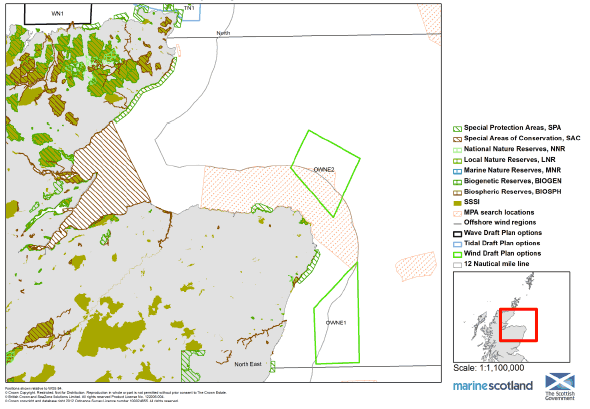
1.2.42 As demonstrated in Figures B1.2.9 - B1.2.12, marine mammals and elasmobranchs can be found within this region. The Moray Firth in particular is renowned for its bottlenose dolphin population, and the Inner Firth has been designated as an SAC for their protection. The nearby Dornoch Firth and Morrich More SAC is designated for the protection of common seals.
1.2.43 Spatial distribution data obtained from Scottish seal monitoring programmes confirms the movement of mainly grey seals, along Scotland's east and north east coasts, and in offshore areas within this region [47] . While no seal haul-out sites have been identified within the plan option areas, there are four seal haul out sites located elsewhere in the region at Findhorn, Ardersier, Loch Fleet and Lothmore between Helmsdale and Brora. The first three are haul out sites for common seals and the fourth for grey seals. The common seal haul-out sites serve a well-studied population based in the Inner Moray Firth, which is known to range widely in the more open parts of this environment. Haul out areas have also been identified outside of the region, near the Firth of Tay and Firth of Forth to the south.
Figure B1.2.9: Grey Seal At-Sea Usage in the North East (Plan Option Areas)
Grey Seal at sea usage. North East area
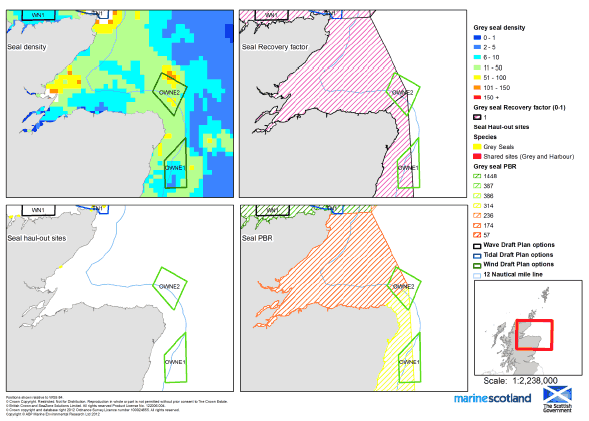
Figure B1.2.10: Harbour Seal At-Sea Usage in the North East (Plan Option Areas)
Harbour Seal at sea usage. North East area
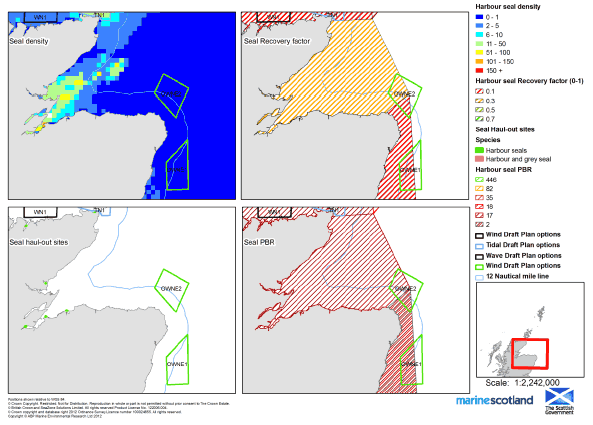
Figure B1.2.11: Basking Shark Sightings and Hotspots in the North East (Plan Option Areas)
Basking shark sightings and hotspots. North East area
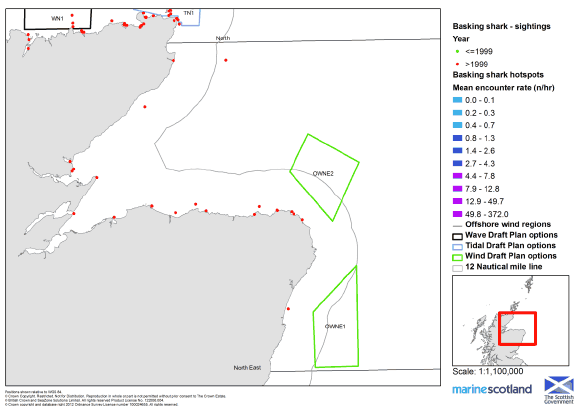
Figure B1.2.12: Cetacean Relative Distribution in the North East (Plan Option Areas)
Cetacean relative distribution. North East area
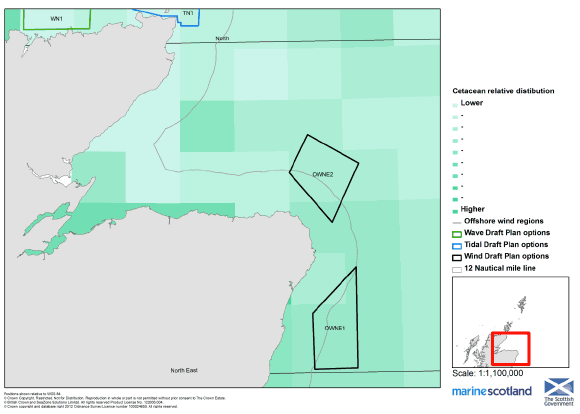
1.2.44 The region also contains spawning or nursery areas for several commercially important species of fish, including high intensity spawning sites for Sandeels and nursery waters for cod and whiting, amongst others [48] . However, there remains a high degree of uncertainty and data gaps, particularly relating to spawning activities.
1.2.45 The River Dee, River Spey, River South Esk, River Oykel and Berriedale and Langwell Waters have been designated as SACs for their importance to Atlantic salmon [49] . River Moriston has also been designated an SAC with Atlantic salmon as a qualifying feature. Many rivers and estuaries along the coastline are also used by Atlantic salmon and Sea trout populations [50] , some of which are at near historic low levels ( e.g. Sea trout populations along the north coast of the Moray Firth and the Aberdeenshire coast).
1.2.46 Two SPAs have been identified in close proximity to the OWNE1 search area. Ythan Estuary, Sands of Forvie and Meikle Loch SPA has been designated to protect breeding and overwintering birds, and supports large populations of Common, Little and Sandwich Terns [51] [52] . Buchan Ness to Collieston SPA is also an important area for breeding seabirds and waterbirds, the most common amongst these being Kittiwake, Northern fulmar, Common guillemots and Herring gulls [53] [54] .
1.2.47 Whilst not a formal designation in Scotland, Important Bird Areas ( IBA) have been identified by Birdlife International for wintering waterbirds at Loch of Strathbeg and Troup Head SPA to the west of OWNE2. This site supports large numbers of breeding seabirds and waterbirds on a regular basis, and is considered to be important for breeding Herring gulls and as one of only two Northern gannet breeding colonies on the UK mainland [55] .
1.2.48 The Moray Firth also contains significant concentrations of seabirds including Black-legged kittiwake, Common guillemot, Atlantic puffin and European shag, amongst others. Five SPAs are located along the Moray Firth coast between Nairn and the East Caithness cliffs, and the coastal areas around the Moray Firth basin are recognised as being internationally important for populations of wintering and passage wildfowl, and nationally important for many breeding species of ducks [56] .
1.2.49 Figures B1.2.13 to B1.2.16 display the locations of IBAs and Royal Society for the Protection of Birds ( RSPB) Reserves in the North East region, and present displacement and collision vulnerabilities for seabirds in this region.
Figure B1.2.13: Seabird Displacement Vulnerability from Wind Energy in the North East (Breeding Season)
Seabird Displacement vulnerability. Wind Energy. North East area (Breeding season)
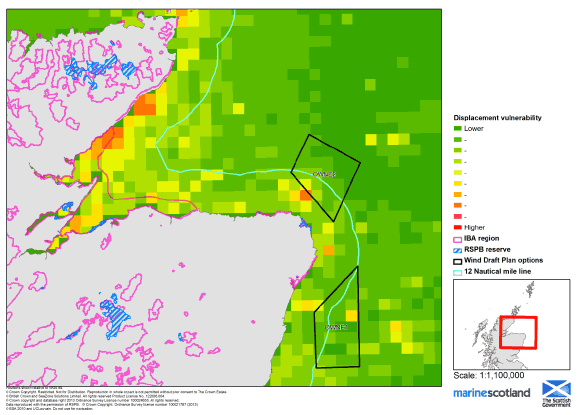
Figure B1.2.14: Seabird Displacement Vulnerability from Wind Energy in the North East (Winter Season)
Seabird displacement vulnerability. Wind Energy. North East area (Winter season)
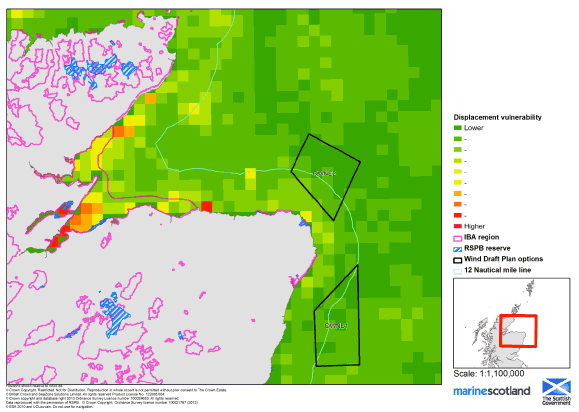
Figure B1.2.15: Seabird Collision Vulnerability from Wind Energy in the North East (Breeding Season)
Seabird collision vulnerability. Wind Energy. North East area (Breeding season)
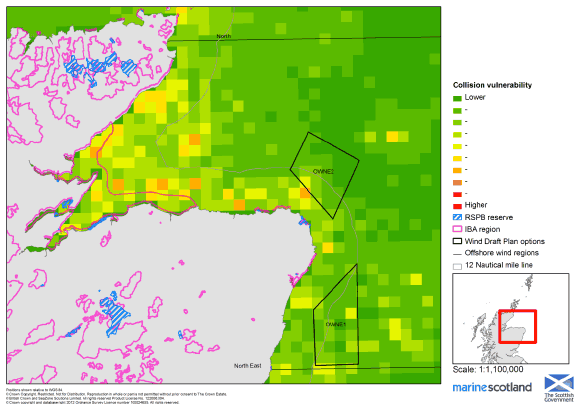
Figure B1.2.16: Seabird Collision Vulnerability from Wind Energy in the North East (Winter Season)
Seabird collision vulnerability. Wind Energy. North East area (Winter season)
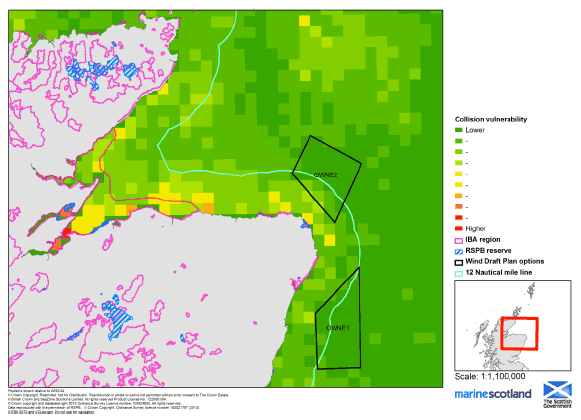
North
1.2.50 In general terms, the habitats in eastern part of this region consist of extensive offshore areas dominated by flat sandy seabeds with large sections of subtidal rock. The nearby inshore firths consist of intertidal rock and sediments such as sandbanks and mudflats, bordered by sandy or rocky coastlines. The western exposed coasts of Shetland and Orkney are generally rockier, and a sharp contrast to the dominant subtidal sediments extending along much of the North Sutherland Coastline.
1.2.51 While much of the region is dynamic, particularly the western coasts of Orkney and the Pentland Firth, the sheltered inlets are recognised for their importance for local biodiversity. Although many of these habitats are in good condition, some shallow subtidal sediments have been adversely impacted from scallop dredging [57] .
1.2.52 Orkney, Shetland and the North Sutherland Coast have a wealth of designated sites and features including [58] :
- SACs located in Orkney, including Sanday SAC, an extensive area designated for its marine habitat features and common seals; and Faray and Holm of Faray SAC designated for grey seals.
- SACs located in Shetland, such as Mousa, North Fetlar and Ronas Hill - North Voe, the Vadills, East Mires and Lumbister, and Sullom Voe designated for their marine features and/or common seals; Yell Sound Coast designated for common seals and otters; and pSAC Pobie Bank Reef located to the east of the Shetland Islands that partly overlaps a plan option area, and supports reef habitats and a range of important species ( e.g. harbour porpoise, grey seal and common seal).
- SACs located along the North Sutherland and Caithness Coast, including Strathy Point, Caithness and Sutherland Peatlands, Durness and Cape Wrath containing a range of habitats and coastal features ( e.g. dunes, dune grassland, bogs and vegetated sea cliffs) and list a range of species as features ( e.g. otters). SACs located at River Naver, Thurso and Borgie have been designated for their importance to Atlantic salmon.
- SPAs located in Orkney, including West Westray, Papa Westray (North Hill and Holm), Calf of Eday, East Sanday Coast, Marwick Head and Rousay SPAs at the northern end of the Isles, and Hoy SPA in the south west. All sites have been designated for their interests for birds.
- SPAs located around Shetland, including Fetlar, Otterswick and Graveland, Ronas Hill - North Roe and Tingan, Papa Stour, Foula, Mousa, Noss, Sumburgh Head, and Hermaness, Saxa Vord and Valla Field SPAs. All of these sites have been designated for their interests for birds, including large assemblages of seabirds. Fair Isle SPA also lies to the south of the region.
- SPAs located along the North Sutherland Coast and Caithness, including the North Caithness Cliffs, Caithness and Sutherland Peatlands, Caithness Lochs, North Sutherland Coastal Islands and Cape Wrath SPAs. All sites have been designated for their interests for birds, including large assemblages of seabirds.
- Possible MPA locations identified around Papa Westray due to black guillemot interests and north west Orkney and Mousa in Shetland due to their role in supporting Sandeels. The Faroe Shetland Channel located north west of Shetland, has been recognised for its role in supporting habitats such as muds, sands and gravels and its aggregations of deep sea sponges. Other possible MPAs in the vicinity are recognised for habitats such as muds, sands and gravels which support and a range of species ( e.g. aggregations of deep sea sponges, horse mussel beds, maerl beds, burrowing bivalves, seabirds such as Black guillemots).
1.2.53 The North region contains two plan option areas for wind energy ( OWN1 and OWN2), three for wave energy ( WN1 - WN3) and seven tidal energy ( TN1 - TN7) plan option areas. The location of these plan option areas to ecological designations are displayed below. The maps demonstrate overlap between several plan option areas and the North West Orkney proposed MPA which is being proposed as a result of features including Sandeels, and geomorphology ( i.e. sand bank, sand wave field, sediment wave fields).
1.2.54 Many of the SACs identified with marine components in Shetland and Orkney are designated for grey and harbour seals. For example, Faray and Holm of Faray SACs contain the second-largest breeding colony in the UK, and Sanday, North Rona and Yell Sound Coast SACs are of importance for grey and common seals respectively. Otters form a further qualifying feature for seven SACs in Orkney and Shetland, with a further two SACs located on the North Sutherland Coast.
1.2.55 The Orkney archipelago, Pentland Firth and Stroma are home to 34 haul-out sites for both grey and common seals, with a further 31 sites for harbour seals and six sites for grey seals in around the Shetland Isles. The waters surrounding both the Shetland and Orkney Isles are home to important seal populations [59] , and both have been declared Harbour (Common) Seal Conservation Areas [60] .
Figure B1.2.17: Biodiversity Designations and Proposed MPAs in the North (Plan Option Areas)
Biodiversity designations. North area
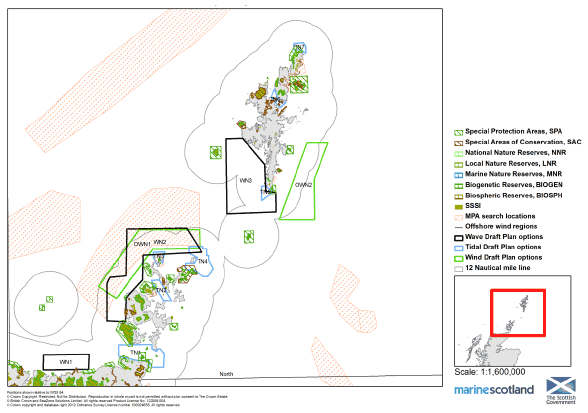
1.2.56 A range of cetacean species are regularly sighted around Orkney and Shetland including Minke whale, Harbour porpoise, Orca, Risso's dolphin and White beaked dolphin. The highest abundance of Orcas has been identified north of Muckle Flugga, particularly during mackerel season (January to March and September-October to December).
1.2.57 The North region contains a number of important nursery areas for several fish species, including commercially important species such as herring, whiting and anglerfish. However, there remains a high degree of uncertainty and data gaps, particularly relating to spawning activities [61] .
1.2.58 While a small number of salmon rivers have been identified within the Northern isles, the majority of significant salmon rivers in this region are located within Caithness and along the North Sutherland Coast. There is also uncertainty relating to the migratory patterns of adult or post-smolt Atlantic salmon within this area, specifically over whether migration occurs through or around Orkney and Shetland, or if the Pentland Firth is the preferred or only route used [62] .
Figure B1.2.18: Grey Seal At-Sea Usage in the North (Plan Option Areas)
Grey Seal at sea usage. North Area
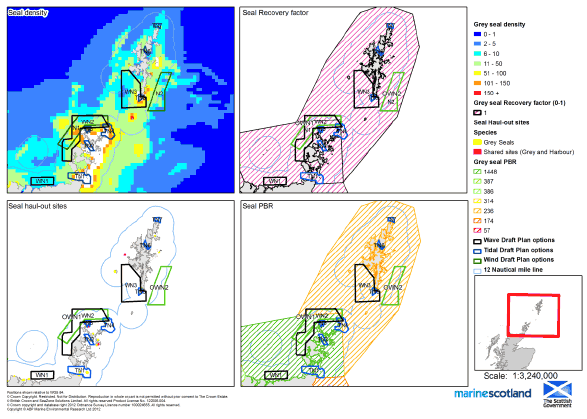
Figure B1.2.19: Harbour Seal At-Sea Usage in the North (Plan Option Areas)
Harbour Seal at sea usage. North area.
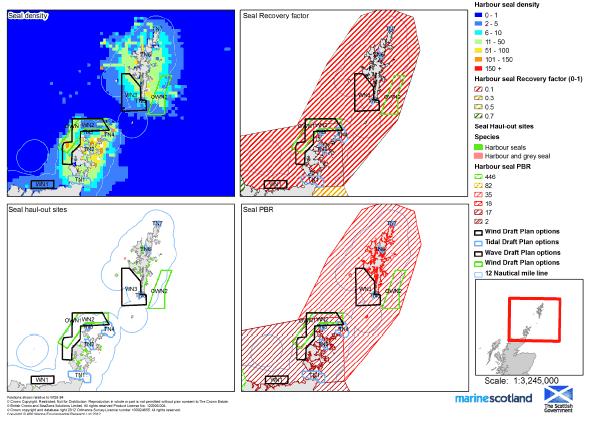
Figure B1.2.20: Basking Shark Sightings and Hotspots in the North (Plan Option Areas)
Basking shark sightings and hotspots. North area
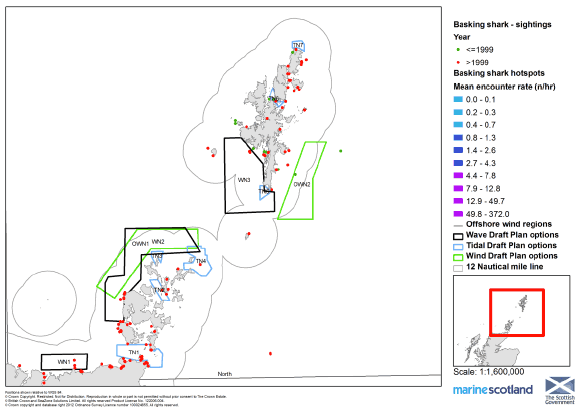
Figure B1.2.21: Cetacean Relative Distribution in the North (Plan Option Areas)
Cetacean relative distribution. North area
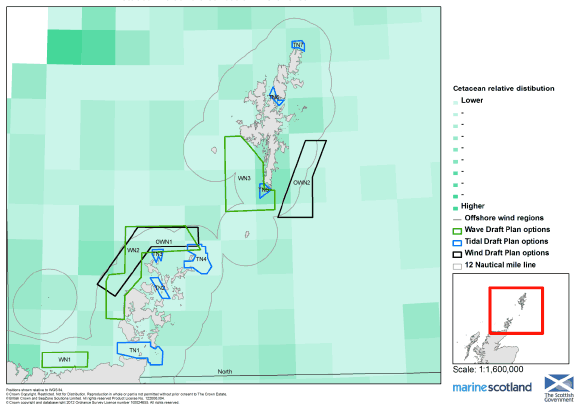
1.2.59 Orkney's six SPAs provide habitats that support a number of important seabird species including Black legged kittiwake, Common and Black guillemot, Atlantic puffin, European shag, Fulmar, Skua, Cormorant, Razorbill and Arctic tern. In many cases, seabird population numbers and breeding success are tightly linked with the availability of fish prey, such as Sandeels.
1.2.60 Shetland also hosts a great variety of breeding and overwintering seabirds and waterbirds. Six SPAs in the Shetland area (including Foula and Fair Isle) provide important habitats that support Arctic tern, Storm petrel, Black backed gull, Black guillemot, Common guillemot, Common tern, Red throated divers, Whimbrel, Ringed plover, Fulmar, Gannet, Duck and eider species, amongst others. Great Skua numbers are high in Shetland and Orkney and it is estimated that over half of the world's population reside in these areas [63] . Fair Isle supports large colonies of breeding seabirds, including Fulmar, Gannets, European shag and Kittiwake, amongst others [64] . The area, designated as an SPA, is also an important stop-over site for migrating birds [65] . During the breeding season, Sumburgh head also supports a range of seabird species including Kittiwake and Fulmar [66] .
1.2.61 Whilst not a formal designation, several IBAs have also been identified by Birdlife International in the region. The largest two areas are located at Hoy [67] , based upon its importance for breeding seabirds, waders and raptors, and at Scapa Flow, considered to be important for wintering waterbirds [68] .
1.2.62 Figures B1.2.22 to B1.2.29 display the locations of IBAs and RSPB Reserves in the North, and also present displacement and collision vulnerabilities of seabirds within this region.
Figure B1.2.22: Seabird Displacement Vulnerability from Wind Energy in the North (Breeding Season)
Seabird Displacement vulnerability. Wind Energy. North area (Breeding season)
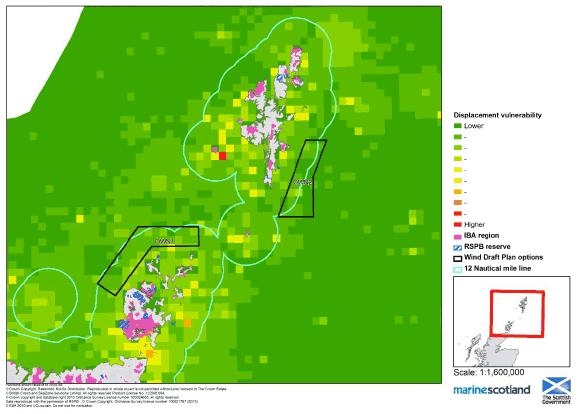
Figure B1.2.23: Seabird Displacement Vulnerability from Wind Energy in the North (Winter Season)
Seabird Displacement vulnerability. Wind Energy. North area (Winter season)
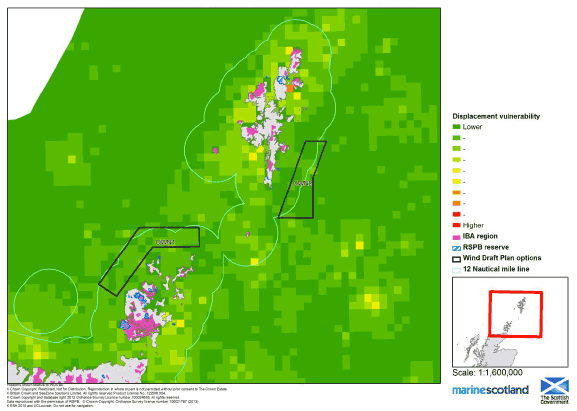
Figure B1.2.24: Seabird Collision Vulnerability from Wind Energy in the North (Breeding Season)
Seabird collision vulnerability. Wind Energy. North area (Breeding season)
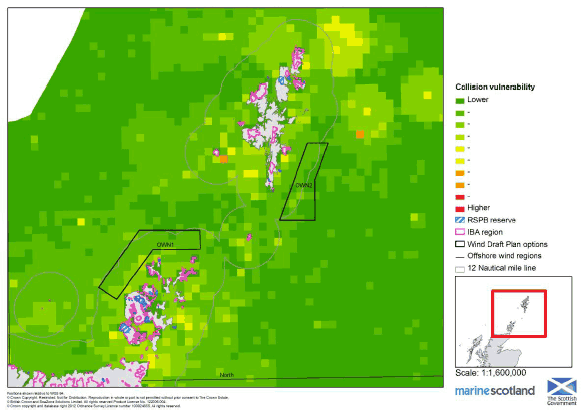
Figure B1.2.25: Seabird Collision Vulnerability from Wind Energy in the North (Winter Season)
Seabird collision vulnerability. Wind Energy. North area (Winter season)
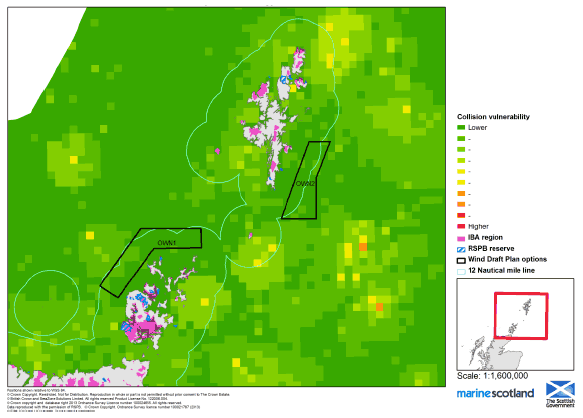
Figure B1.2.26: Seabird Collision Vulnerability from Wave Energy in the North (Breeding Season)
Seabird collision vulnerability. Wave energy. North area (Breeding season)
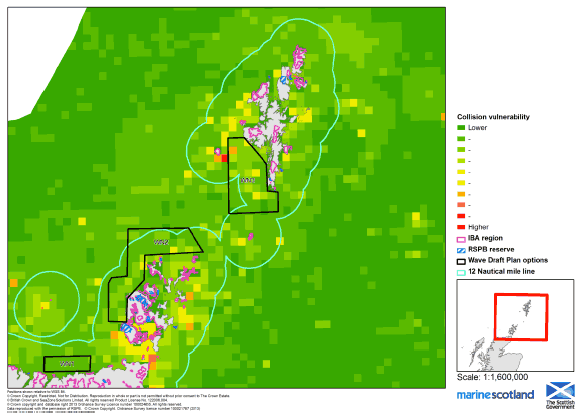
Figure B1.2.27: Seabird Collision Vulnerability from Wave Energy in the North (Winter Season)
Seabird collision vulnerability. Wave energy. North area (Winter season)
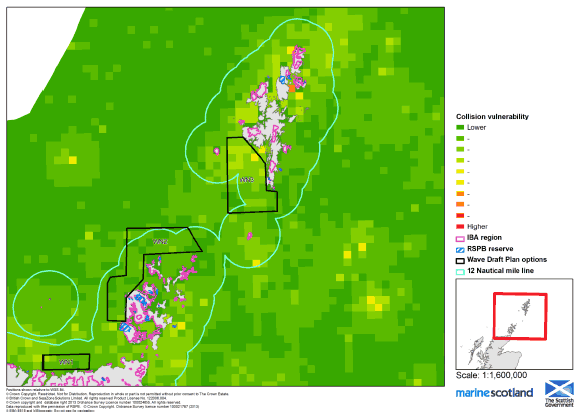
Figure B1.2.28: Seabird Collision Vulnerability from Tidal Energy in the North (Breeding Season)
Seabird collision vulnerability. Tidal Energy. North area (Breeding season)
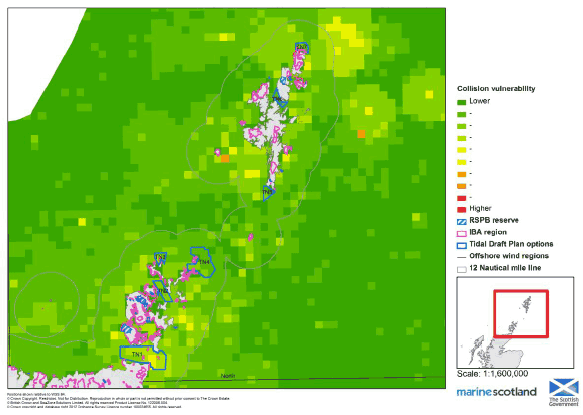
Figure B1.2.29: Seabird Collision Vulnerability from Tidal Energy in the North (Winter Season)
Seabird collision vulnerability. Tidal Energy. North area (Winter season)
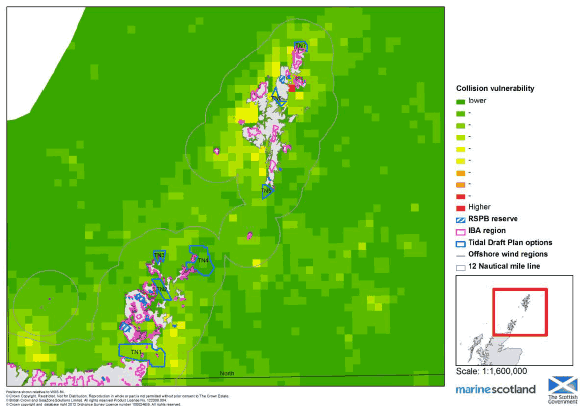
North West
1.2.63 In general terms, the coastal and marine habitats vary across this region, ranging from shallow and shelf subtidal sediments within the Minches, to expansive shallow subtidal sediment and rock habitats west of the Outer Hebridean Isles. While sections of the Lewis coastline and the North West region of the Scottish mainland consist of intertidal rock interspersed with intertidal sediment habitats in some areas, the coastlines themselves can have vastly different appearances. The large fjordic sea lochs and sheltered sandy beaches of the west coast of the mainland provide stark contrast with the exposed and primarily rocky coastlines of Lewis.
1.2.64 While these habitats are in relatively good condition overall, pressures such as trawling and scallop dredging on benthic habitats in shallow subtidal habitats, and declines in populations from catches of non-target species have raised concerns in these areas [69] .
1.2.65 The north west area has a number of important and designated sites including [70] :
- SACs such as the Langavat and North Harris SACs located in the western region of Lewis, both designated for their Atlantic Salmon interests; coastal protected areas on the Scottish mainland including Oldshoremore and Sandwood SAC designated for its dunes and machair; North Rona SAC designated for its sea cliffs, caves, reefs, and importance to grey seal populations; the Sound of Barra pSAC proposed for its reefs, sandbanks and qualifying habitat essential to the reproduction of harbour seal; and cSACs such as the offshore Darwin Mounds, Wyville Thomson Ridge and Solan Bank Reef sites for their important reef features;
- SPAs including North Rona and Sula Sgeir SPA, Sule Skerry SPA and Sule Stack SPA, designated for their seabird interests. In some instances, designated sites such as Flannan Isles SPA, are located within a plan option area ( WNW1);
- Onshore protected areas such as Cape Wrath, Handa and the extensive Lewis Peatlands SPAs are also protected for a number of bird species, and may have coastal or marine relevance; and
- Potential MPAs located around the north east coast of Lewis based upon its value for Sandeels and Risso's dolphin, the Shiant Isles located further into the Minch, and two further areas in the North Minch and to the west of Lewis due to their interests for white-beaked dolphins. On the Sutherland Coast, an area known as the North West Sea Lochs and Summer Isles has also been included for further assessment as an MPA due to its value as a sea loch habitat.
1.2.66 The North West region contains one wind ( OWNW1) and one wave ( WNW1) plan option area. The proximity of these areas to ecological designations is displayed in Figure B1.2.30.
Figure B1.2.30: Biodiversity Designations and Proposed MPAs in the North West (Plan Option Areas)
Biodiversity designations. North West area
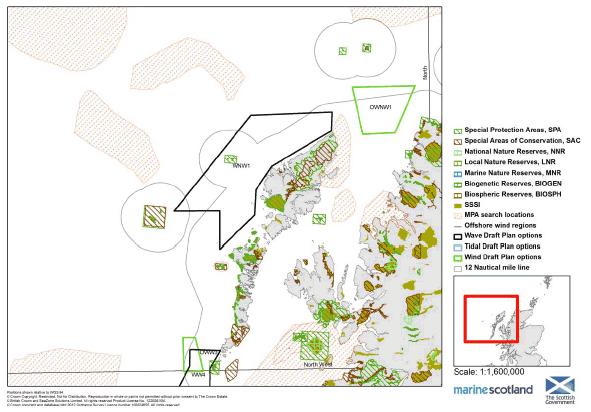
1.2.67 Many cetacean species are frequently sighted around the North Minch, including Minke whale, Orca, White beaked dolphin, Short beaked common dolphin, Risso's dolphin and Harbour porpoise.
1.2.68 While not regarded a 'hotspot', sighting data indicates that this area is used by Basking sharks [71] . Seal monitoring data indicates several areas of high activity are present within the region, including coastal areas near Cape Wrath for grey seals, and to the west of Harris and North Uist for both grey and common seals [72] . A seal SAC has been established to the south at Ascrib, Isay and Dunvegan off the Isle of Skye for common seals, and seal haul-out sites are located at various points along the north east coast of the mainland, to the north and east of the Isle of Skye, to the west and east of Uist, and to east of Lewis.
Figure B1.2.31: Grey Seal At-Sea Usage in the North West (Plan Option Areas)
Grey Seal at sea usage. North West area
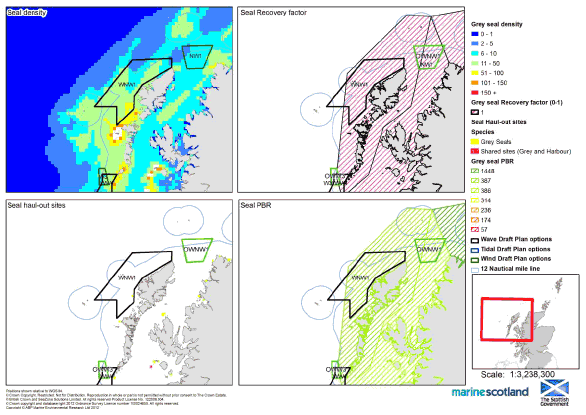
Figure B1.2.32: Harbour Seal At-Sea Usage in the North West (Plan Option Areas)
Harbour Seal at sea usage. North West area.
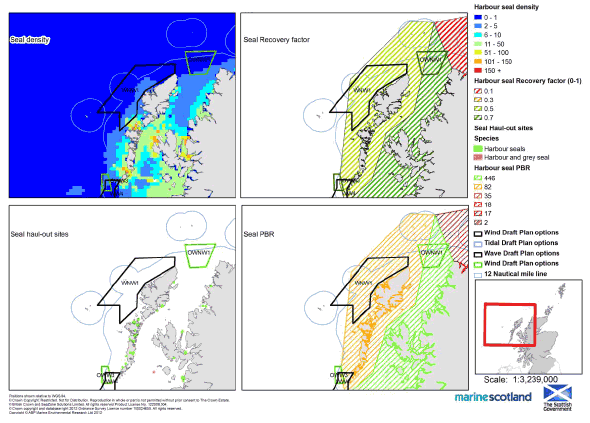
Figure B1.2.33: Basking Shark Sightings and Hotspots in the North West (Plan Option Areas)
Basking shark sightings and hotspots. North West area
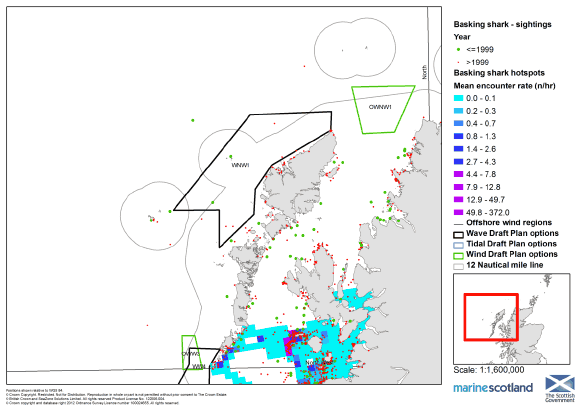
Figure B1.2.34: Cetacean Relative Distribution in the North West (Plan Option Areas)
Cetacean Relative distribution. North West area
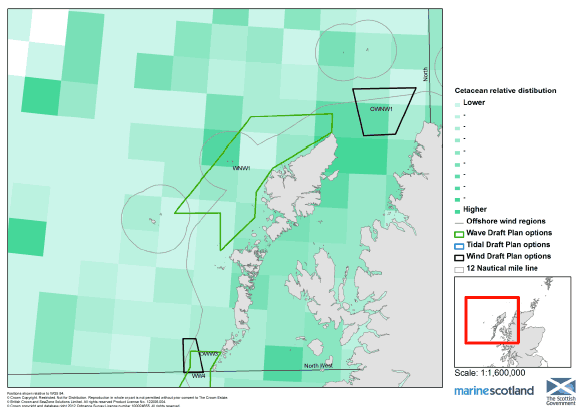
1.2.69 A number of high intensity nursery grounds have been identified within the region for commercially fish species such as herring, whiting and mackerel, amongst others. However, there remains a high degree of uncertainty and data gaps for many species, particularly relating to spawning activities [73] .
1.2.70 SACs have been designated at North Harris and Langavat for their importance for Atlantic salmon. However, other rivers in the region, both in the Hebridean Isles and the North West region of the Scottish mainland are also likely to be used by Atlantic salmon and Sea trout populations [74] .
1.2.71 The North West region contains many important areas for seabirds including SPAs at Cape Wrath, Handa Island, Sula Sgeir and Sule Skerry, and Sule Stack. These areas provide important habitats for nesting and breeding birds, including Petrel, Auk, Gull, Gannet, Fulmar, Common guillemot and Black legged kittiwake. Flannan Islands SPA located to the west of Lewis also provides nesting for similar bird species, but is also regarded as an important site for Leach's Petrel and is one of only seven known nesting localities in the EU [75] .
1.2.72 Several IBAs have also been identified in this region by Birdlife International, including large proportions of Lewis and Harris, and a blend of large and small areas in Highland areas in the north west portion of the Scottish mainland. Whilst not a formal designation, the identification of these areas provides an additional layer of data for consideration in this baseline, and adds weight to the importance attributed to sites such as Cape Wrath [76] and the Lewis Peatlands [77] for breeding seabirds and waterbirds.
1.2.73 Figures B1.2.35 to B1.2.40 display the locations of IBAs and RSPB Reserves in the North West region, and presents displacement and collision vulnerabilities of seabirds within this region.
Figure B1.2.35: Seabird Displacement Vulnerability from Wind Energy in the North West (Breeding Season)
Seabird Displacement vulnerability. Wind Energy. North West area (Breeding season)
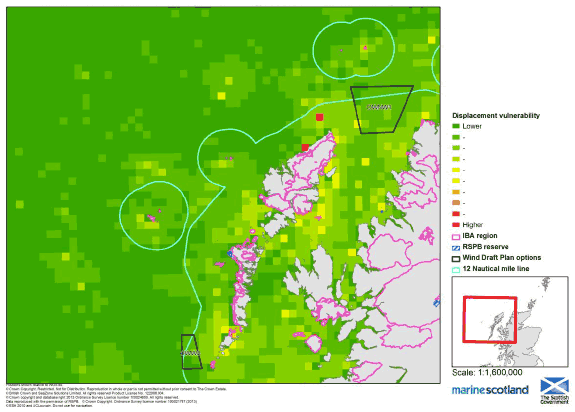
Figure B1.2.36: Seabird Displacement Vulnerability from Wind Energy in the North West (Winter Season)
Seabird displacement vulnerability. Wind Energy. North West area (Winter season)
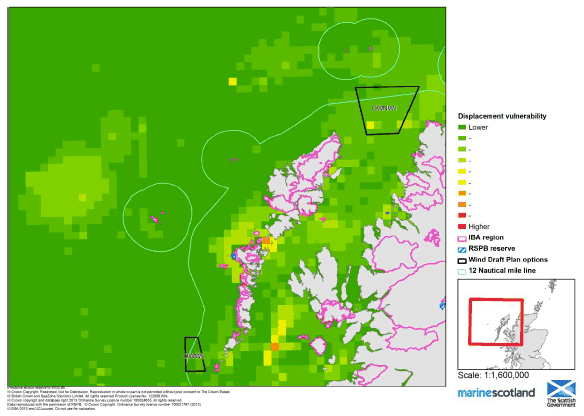
Figure B1.2.37: Seabird Collision Vulnerability Risk from Wind Energy in the North West (Breeding Season)
Seabird collision vulnerability. Wind Energy. North West area (Breeding season)
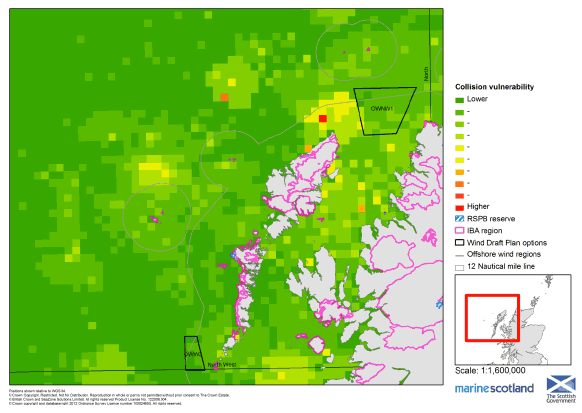
Figure B1.2.38: Seabird Collision Vulnerability from Wind Energy in the North West (Winter Season)
Seabirds collision vulnerability. Wind Energy. North West area (Winter season)
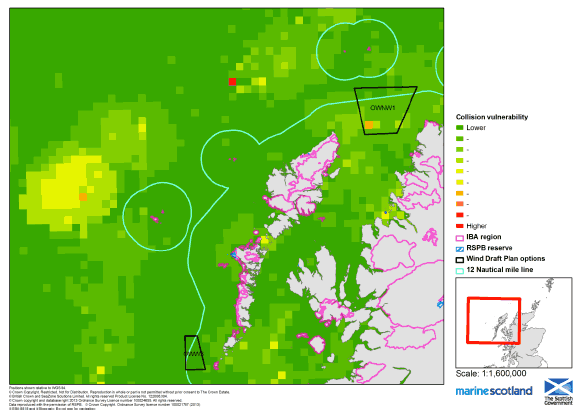
Figure B1.2.39: Seabird Collision Vulnerability from Wave Energy in the North West (Breeding Season)
Seabird collision vulnerability. Wave energy. North West area (Breeding seaon)
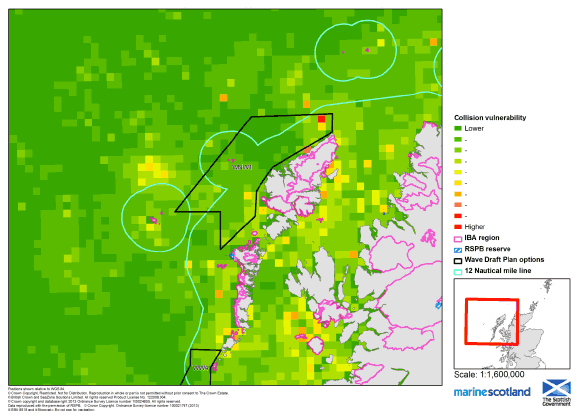
Figure B1.2.40: Seabird Collision Vulnerability from Wave Energy in the North West (Winter Season)
Seabird collision vulnerability. Wave energy. North West area (Winter season)
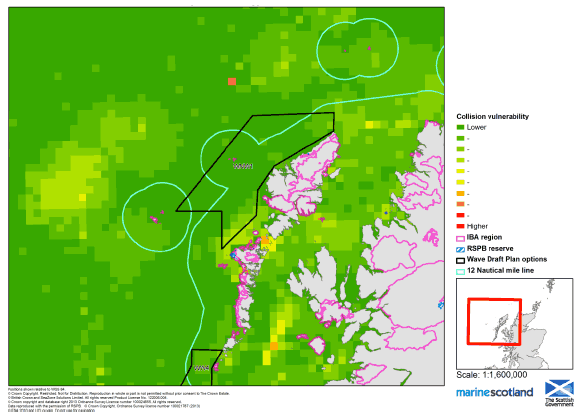
West
1.2.74 The coastal and marine habitats vary throughout this region, ranging from predominantly shallow and shelf subtidal sediments amongst and to the west of the Inner Hebrides, to subtidal rock regions west and south west of Barra. This variation in habitat type supports a diverse range of marine flora and fauna including, amongst others, cold water coral reefs near Mingulay, Sea pen and Nephrops grounds, and marine mammals and seabirds amongst the Inner Hebrides.
1.2.75 While these habitats are considered to be in relatively good condition overall, pressures from activities such as trawling, particularly in relation to shallow subtidal sediment habitats, and declines in some fish and marine mammal species have prompted concern in some areas [78] .
1.2.76 Designated sites within the West region include [79] :
- SACs including the South East Islay Skerries SAC designated for harbour seals, and candidate areas located close to but outwith the plan option areas at East Mingulay cSAC and Stanton Banks cSAC. Both of these sites have been identified as candidate sites for their reef features;
- SPAs including Rum for its seabird, diver and Golden eagle interests. This site has also been recognised as an SAC to protect its rich diversity of habitats. Other SPA sites identified include the Rinns of Islay SPA, SSSI and Ramsar site designated for birds and habitat features; Laggan SPA designated for birds and habitat features; the Oa SPA and SSSI protected for habitat and Chough interests; the Tiree Wetlands and Coast SPA protected for a number of bird species including geese and waders; Coll SPA protected for geese; and the Mingulay and Berneray SPA protected for a range of seabirds ( i.e. Puffin, Guillemot, Fulmar, Kittiwake, Shag and Razorbill).
- SSSI located amongst the Inner Hebrides and along the Kintyre coastline, many of which have also been designated as SACs and SPAs. The Sanda Islands SSSI, protected for its bird interests ( e.g. Black guillemot) and located off the Kintyre peninsula, has been identified within an MPA area of search;
- Northern Irish protection areas have also been identified as being of potential relevance due to their proximity to several plan option areas in the southern part of this region. These sites include Rathlin Island, Red Bay and North Antrim Coast SACs, each protected for their marine and/or coastal habitats.
- A number of proposed MPAs are located within the region, including the large Skye to Mull MPA search area.
1.2.77 The West region contains three wind ( OWW1 - OWW3), four wave ( WW1 - WW4) and two tidal ( TW1 - TW2) plan option areas. The proximity of these areas to ecological designations is displayed in Figure B1.2.41, which also shows an overlap between some of the plan option areas ( OWW2, WW2 and WW3) and the Skye to Mull MPA search area, and one tidal plan option area ( TW2) to the MPA search area to the south of the Kintyre peninsula.
Figure B1.2.41: Biodiversity Designations and Proposed MPAs in the West (Plan Option Areas)
Biodiversity designations. West area
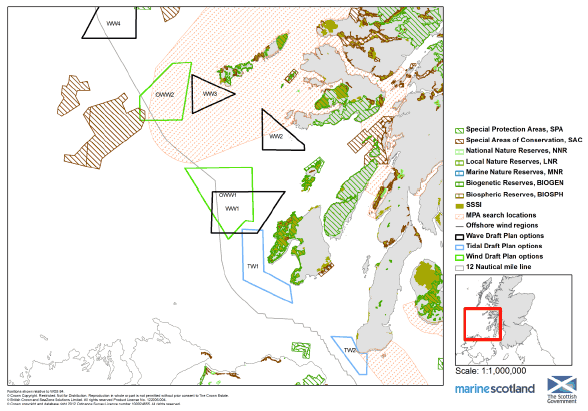
1.2.78 A range of cetacean species are often sighted in this region and around the plan option areas, including Harbour porpoise, Minke whale, Short beaked common dolphin, White beaked dolphin and Orca. Other species, such as White sided dolphin, Bottlenose dolphin and Risso's dolphin have also been observed in these waters [80] [81] . Elasmobranchs are commonly observed in this region, with several Basking shark and Common skate 'hotspots' identified, in particularly one in the vicinity of Mull and Coll where a healthy but critically endangered population of skate has been identified [82] .
1.2.79 The Basking shark 'hotspots' are based around Hyskeir, Canna, Gunna Sound, Coll, West Mull and the Treshnish Isles, the Clyde Sea and South of Barra [83] . This area has been the focus of Basking shark tagging studies, with several studies suggesting that the Inner Hebrides may be an important summer habitat for the Basking sharks. However, further data will be required to confirm the preliminary observations of these studies [84] .
1.2.80 SACs established at the Treshnish Isles and Monach Islands have been recognised for their importance to grey seals, and SACs at the Isle of Lismore and Islay Skerries have been established due to their importance to common seals. There are a number of seal haul out areas within the region including sites near Oronsay, Mull, Jura and Islay and the Kintyre peninsula.
1.2.81 The region contains important nursery grounds for several commercially important species of fish, including Spurdog, Herring, Whiting and Anglerfish amongst others. However, there remains a degree of uncertainty and spatial data gaps, particularly in relation to fish spawning sites in Scottish waters [85] . While no rivers in the region have been designated for their importance for Atlantic salmon, many rivers and estuaries in the region are known to be used by both Atlantic salmon and Sea trout.
Figure B1.2.42: Grey Seal At-Sea Usage in the West (Plan Option Areas)
Grey Seal at sea usage. North West area
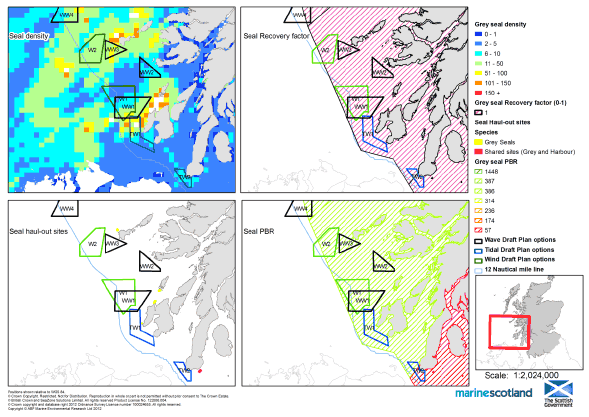
Figure B1.2.43: Harbour Seal At-Sea Usage in the West (Plan Option Areas)
Harbour Seal at sea usage. West area.
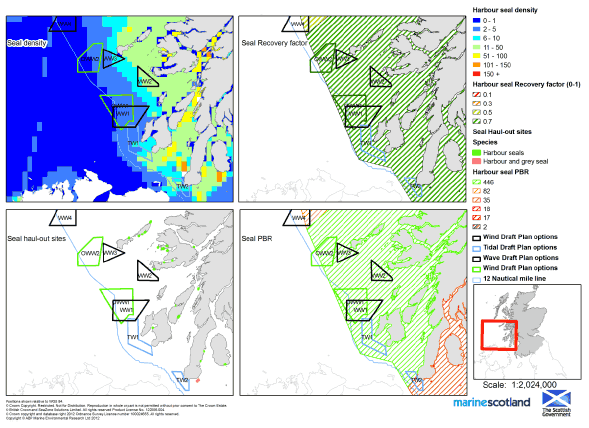
Figure B1.2.44: Basking Shark Sightings and Hotspots in the North (Plan Option Areas)
Basking shark sightings and hotspots. West area
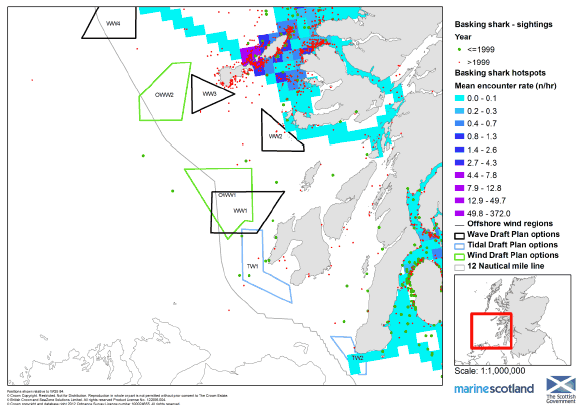
Figure B1.2.45: Cetacean Relative Distribution in the West (Plan Option Areas)
Cetacean relative distribution. West area
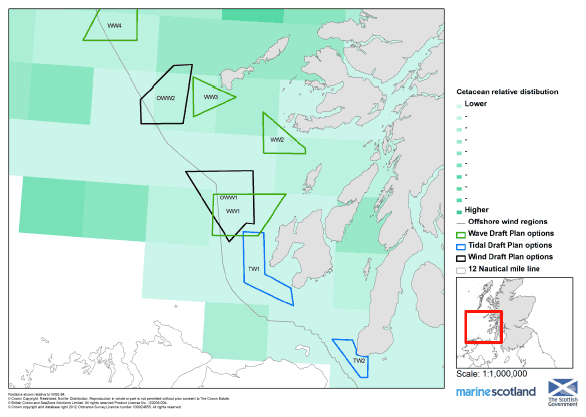
1.2.82 Several SPAs been established within close proximity of the plan option areas in the west region, including:
- Canna and Sanday which supports a range of seabird species including Puffin, Guillemot, Kittiwake, Herring Gull and Shag [86] ;
- The isle of Rum is noted for its colony of Manx shearwater, whilst also supporting other breeding seabirds such as Kittiwake, Guillemot, Auk, Gull, and rarer species like the Golden eagle [87] [88] ;
- Mingulay and Berneray, located near the border of the West and North West regions, are designated as important breeding sites for a range of bird species including Razorbill, Puffin, Guillemot, Fulmar, Kittiwake and Shag. Many of these species are known to feed in the surrounding waters of the South Minch [89] ;
- The Treshnish Isles are considered to be important for their breeding seabird colonies, especially those of the Storm petrel. While the most important seabird colonies are on Lunga, which also supports the majority of the Storm petrel populations, the Isles are also considered to be important for wintering Greenland Barnacle Goose [90] ;
- North Colonsay and the Western cliffs are important for breeding seabirds such as Gulls and Auks [91] , as well as Guillemot and Kittiwakes during breeding season [92] . These birds are known to feed outside the SPA in surrounding waters, as well as those located further afield. Chough is also a resident species of cliffs in these areas [93] and SPAs have been established at Oronsay and South Colonsay to protect both Chough and Cornkrake populations;
- Gruinart Flats [94] , Bridgend Flats [95] and Laggan [96] are designated for the protection of passing populations of Barnacle goose and/or Greenland white fronted goose; and
- Ailsa Craig is protected for its important nesting and breeding sites for a range of seabird species, including Guillemot, Gull, Kittiwake, and most notably, one of the largest colonies of Gannet in the world. The seabirds nesting here feed in surrounding waters outside the SPA as well as in marine areas further afield [97] .
1.2.83 In addition to sites of European importance, several IBAs have been identified across the West region. The Colonsay and Oronsay IBA reflects the presence of seabird species such as breeding Common guillemot and Black legged kittiwake populations. Rarer species such as the Corncrake have also been recorded in this area. Other IBAs in the region including those on Mull, Tiree, Coll, Islay, the Kintyre peninsula, Gigha Island, Machrihanish and the Arran Moors support a range of important bird species;
1.2.84 Figures B1.2.46 - B1.2.53 display the locations of IBA and RSPB Reserves in the North West, and present displacement and collision vulnerabilities for seabirds within the region.
Figure B1.2.46: Seabird Displacement Vulnerability from Wind Energy in the West (Breeding Season)
Seabird Displacement vulnerability. Wind Energy. North West area (Breeding season)
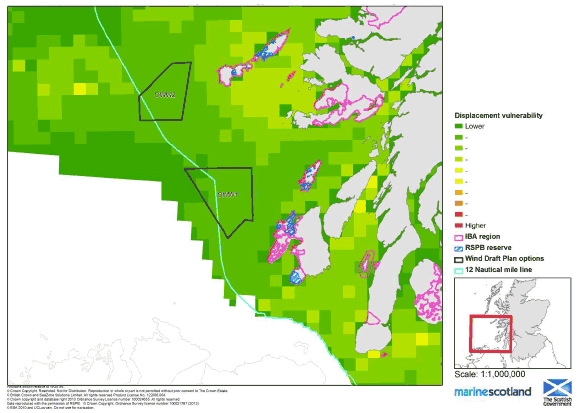
Figure B1.2.47: Seabird Displacement Vulnerability from Wind Energy in the West (Winter Season)
Seabird displacement vulnerability. Wind Energy. West area (Winter season)
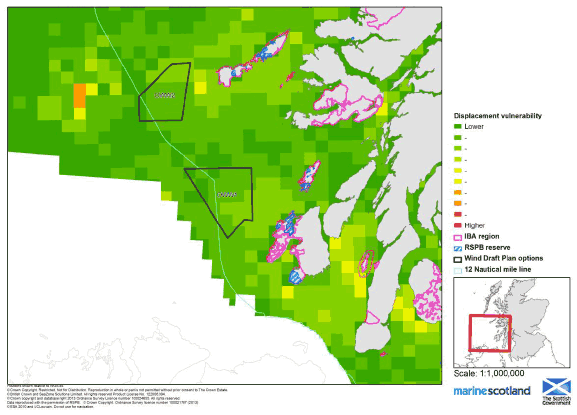
Figure B1.2.48: Seabird Collision Vulnerability from Wind Energy in the West (Breeding Season)
Seabird collision vulnerability. Wind Energy. West area (Breeding season)
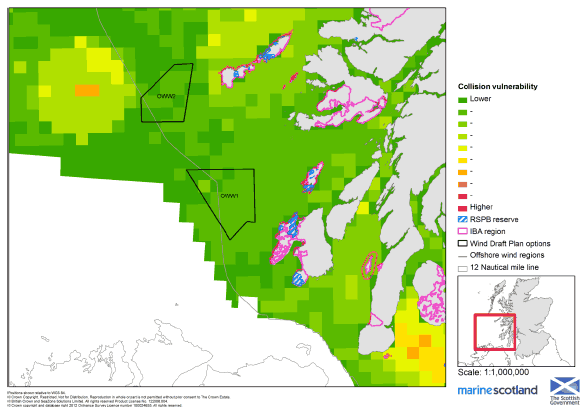
Figure B1.2.49: Seabird Collision Vulnerability from Wind Energy in the West (Winter Season)
Seabird collision vulnerability. Wind Energy. West area (Winter season)
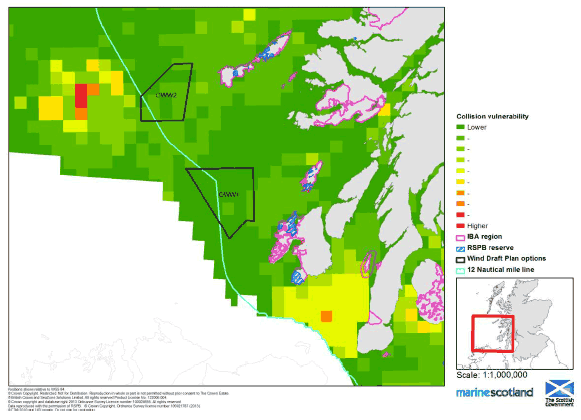
Figure B1.2.50: Seabird Collision Vulnerability from Wave Energy in the West (Breeding Season)
Seabird collision vulnerability. Wave energy. West Area (Breeding season)
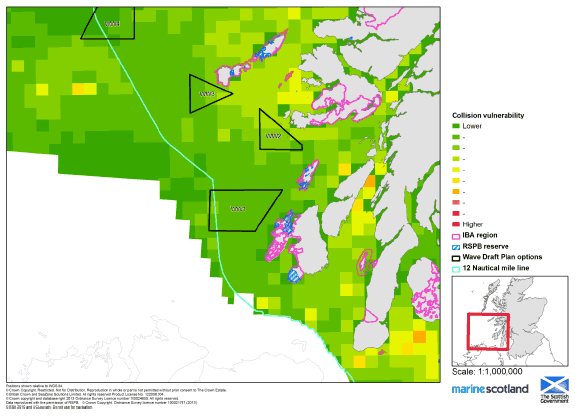
Figure B1.2.51: Seabird Collision Vulnerability from Wave Energy in the West (Winter Season)
Seabird collision vulnerability. Wave Energy. West area (Winter season)
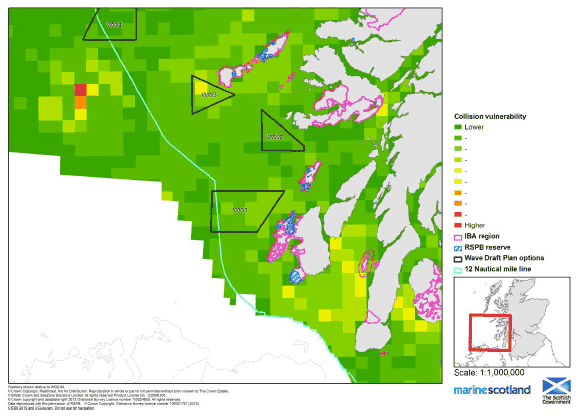
Figure B1.2.52: Seabird Collision Vulnerability from Tidal Energy in the West (Breeding Season)
Seabird collision vulnerability. Tidal Energy. West area (Breeding season)
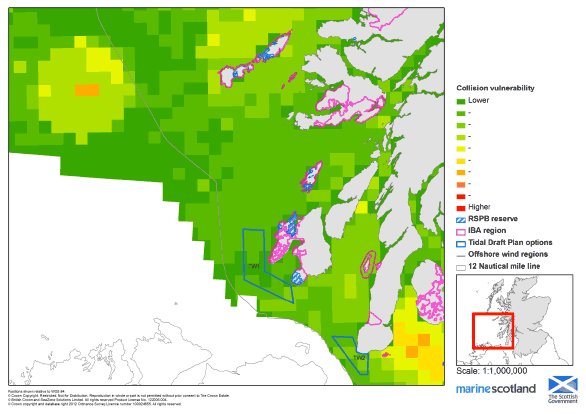
Figure B1.2.53: Seabird Collision Vulnerability from Tidal Energy in the West (Winter Season)
Seabird collision vulnerability. Tidal Energy. West area (Winter season)
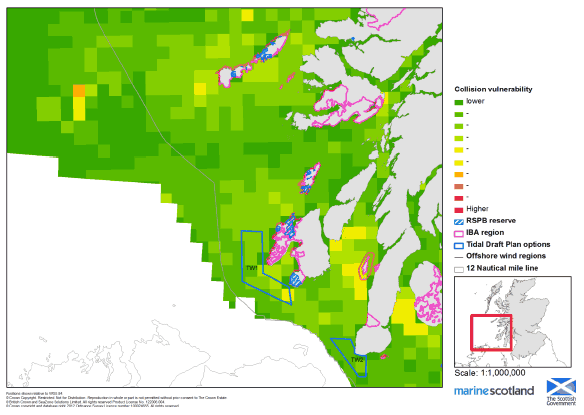
South West
1.2.85 While largely expansive shallow and shelf subtidal sediments extend across this region, the coastal habitats within the Solway Firth vary from west to east. The Luce Bay coastline largely consists of intertidal rock habitats, changing to predominantly intertidal sediments near the entrance to the River Nith at the eastern edge of the Firth. Several of these areas have been recognised and designated for their importance to a number of different species.
1.2.86 The status of these habitats within the region is largely mixed. Intertidal rocky and sediment habitats are generally deteriorating, with rocky habitats noted as being under threat from invasive non-native species such as wireweed ( Sargassum muticum). While shallow subtidal rocky habitats are generally considered to be in a better state, the shallow subtidal habitats present in the region are considered to be relatively degraded. In a species context, the reduced populations of some fish species, particularly commercial species, is considered to be of major concern [98] .
1.2.87 The South West region and its neighbouring areas have a wealth of designated sites and features [99] :
- SACs including Luce Bay and Sands SAC designated for its coastal and inshore habitats and its support for Great crested newts; the Solway Firth SAC that overlaps with the Solway Firth SPA and Ramsar sites, and designated for its estuarial / coastal habitat and species features ( e.g. River lamprey and Sea lamprey); River Bladnoch SAC designated for its Atlantic salmon interests; and Mull of Galloway SAC designated for its vegetated sea cliffs.
- SPAs including the Upper Solway Flats and Marshes designated as both an SPA and Ramsar site for the bird species it supports; Loch of Inch and Torrs Warren SPA located at the northern end of Luce Bay, designated for its support for Hen harrier and Greenland white-fronted goose species; and Loch Ken, River Dee Marshes, and Glenapp and the Galloway Moors SPAs located inland but with the potential for coastal relevance. The Rinns of Islay SPA, SAC and SSSI was designated for a range of bird species and other features, and has also been included due to its proximity to the plan option areas;
- Numerous SSSI and local nature conservation designations in the region, including some with particular relevance to development offshore. These include the Cree Estuary SSSI notified for a range of features including Smelt, Pink-footed goose, coastal geomorphology, and saltmarsh and mudflats; Loch Ryan which is highlighted as a Marine Consultation Area; Wigtown Bay Local Nature Reserve; and the Cairnsmore of Fleet, Merrick Kells and Silver Flowe Biosphere Reserves
- Designated areas in Northern Ireland and England, including Strangford Lough (Northern Ireland) and Drigg Coast (England) SACs, St. Bee's Head Heritage Coast located in Cumbria, and several SSSI and local natural heritage designations also located along the Cumbrian coast. On the Isle of Man, there are 17 Areas of Special Scientific Interest (one of which is also a National Nature Reserve) and Ballaugh Curragh that has been designated as a Ramsar site due to bird interests.
1.2.88 The South West region contains two wind ( OWSW1 and OWSW2) and one tidal ( TSW1) plan option areas. The proximity of these areas to ecological designations is displayed in Figure B1.2.54.
Figure B1.2.54: Biodiversity Designations and Proposed MPAs in the South West (Plan Option Areas)
Biodiversity designations. South West area
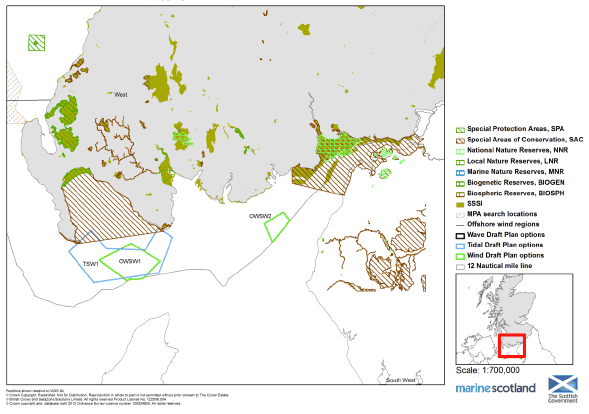
1.2.89 In general terms, the South West region has a lower diversity of marine mammals than other regions. Harbour porpoise are perhaps the most regular users, particularly in the eastern regions of the Solway Firth, with occasional encounters with the Short-beaked common dolphin. Risso's dolphin and White beaked dolphin encounters are quite low [100] . Whilst the area is not a 'hotspot' for Basking sharks, sightings have been recorded around the coastal areas of Luce Bay, Wigtown Bay and the Isle of Man over the last 25 years, including a number of sightings near to plan option areas OWSW1 and TSW1.
1.2.90 None of the SAC sites in this region have been established for seal interests. However, several seal haul-out sites have been identified in the general area at Little Scares, immediately outside of Luce Bay and within the Solway Firth at the outer sandbanks. Both of these sites are used by grey seals.
1.2.91 The waters of the Solway Firth and the northern portion of the Irish Sea contain known nursery areas for several fish species, particularly the eastern portion of the Firth, including commercially important species such as Spurdog, Herring, Cod, Whiting and Sole amongst others. Spawning areas for Plaice and Sole have been identified within the eastern portion of the Solway Firth, although there is a high degree of uncertainty in available spawning and nursery data.
1.2.92 The River Bladnoch has been designated as an SAC for its importance to Atlantic salmon [101] . However, many rivers and estuaries along the coastline of the Solway Firth are known to be used by Atlantic salmon populations for spawning and nursery grounds, and also support important Sea trout populations [102] .
Figure B1.2.55: Grey Seal At-Sea Usage in the South West (Plan Option Areas)
Grey Seal at sea usage. South West area
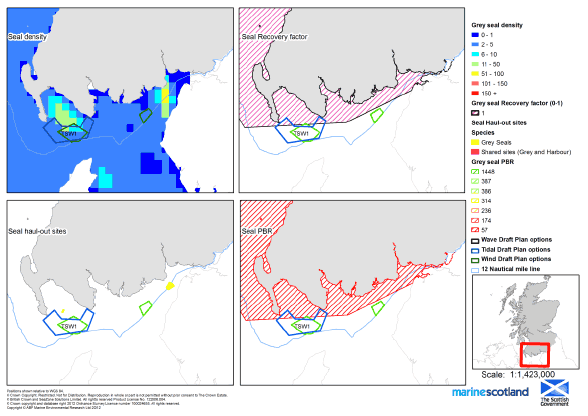
Figure B1.2.56: Harbour Seal At-Sea Usage in the South West (Plan Option Areas)
Harbour Seal at sea usage. South West area.
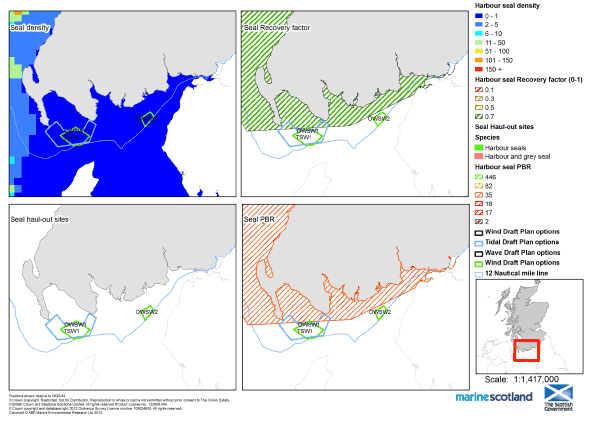
Figure B1.2.57: Basking Shark Sightings and Hotspots in the South West (Plan Option Areas)
Basking shark sightings and hotspots. South West area.
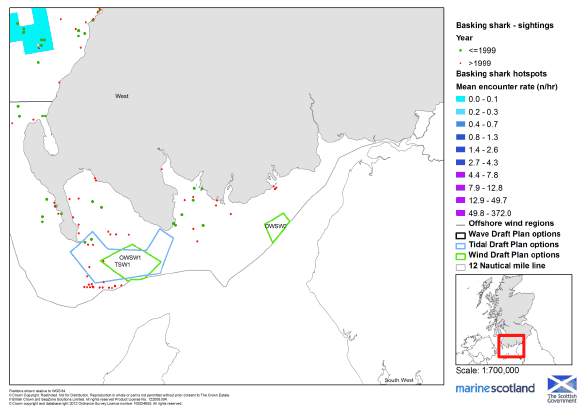
Figure B1.2.58: Cetacean Relative Distribution in the South West (Plan Option Areas)
Cetacean relative distribution. South West area.
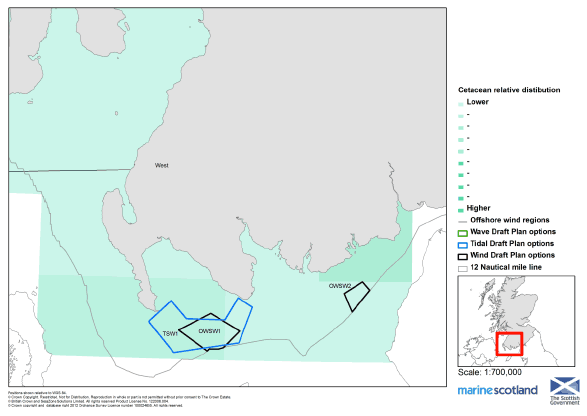
1.2.93 The Solway Firth area supports a variety of species of seabirds, particularly during breeding season, reflected in the designation of sites such as the Upper Solway Flats and Marshes, Loch of Inch and Torrs Warren SPA, Rinns of Islay SPA, and inland areas such as Loch Ken, River Dee Marshes, and Glenapp and the Galloway Moors SPAs. Together, these areas support species such as Greater cormorant, Black headed gull, Common gull, Sandwich tern, Manx shearwater, and, to a lesser degree, Northern gannet, Razorbills, Hen harrier and Geese [103] . Outside the breeding season, species numbers within this area are generally reduced with the exception of Black headed gulls which concentrate their numbers inshore near Luce Bay [104] .
1.2.94 IBAs have been identified by Birdlife International at Luce Bay and Loch of Inch and Torrs for their importance for wintering geese. The IBA at Loch Ryan supports important numbers of wintering waterbirds, while others found at Mochrum and Castle Lochs, Wigtown Bay and Upper Solway flats and Marshes, reflect the importance of these areas for wintering wildfowl and waders [105] [106] . Figures B1.2.59 to B1.2.64 display displacement and collision vulnerabilities of seabirds within the South West region.
Figure B1.2.59: Seabird Displacement Vulnerability from Wind Energy in the South West (Breeding Season)
Seabird Displacement vulnerability. Wind Energy. South West area (Breeding season)
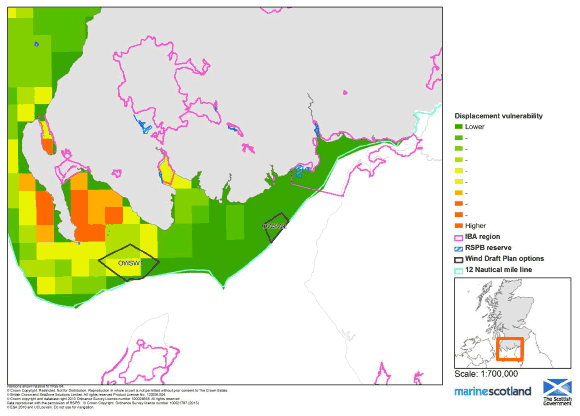
Figure B1.2.60: Seabird Displacement Vulnerability from Wind Energy in the South West (Winter Season)
Seabird displacement vulnerability. Wind Energy. South West area (Winter season)
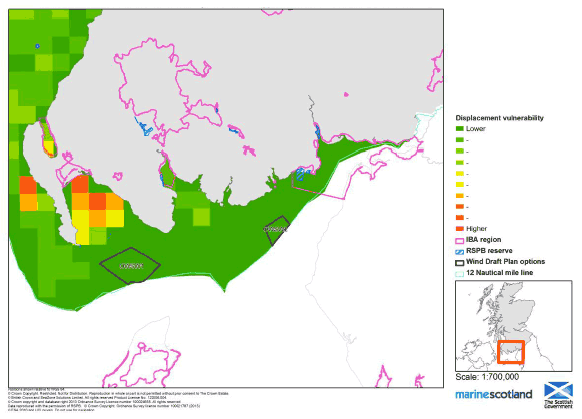
Figure B1.2.61: Seabird Collision Vulnerability from Wind Energy in the South West (Breeding Season)
Seabird collision vulnerability. Wind Energy. South West area (Breeding season)
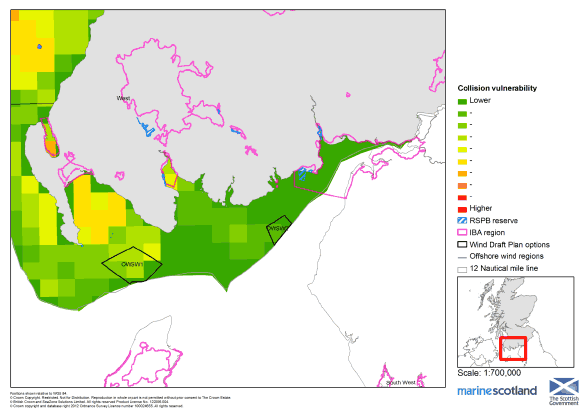
Figure B1.2.62: Seabird Collision Vulnerability from Wind Energy in the South West (Winter Season)
Seabird Collision vulnerability. Wind Energy. South West area (Winter season)
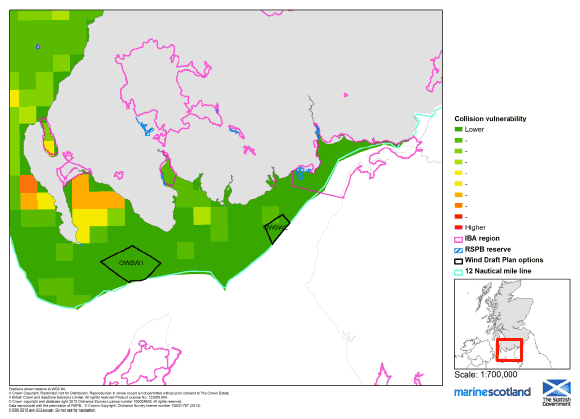
Figure B1.2.63: Seabird Collision Vulnerability from Tidal Energy in the South West (Breeding Season)
Seabird collision vulnerability. Tidal Energy. South West area (Breeding season)
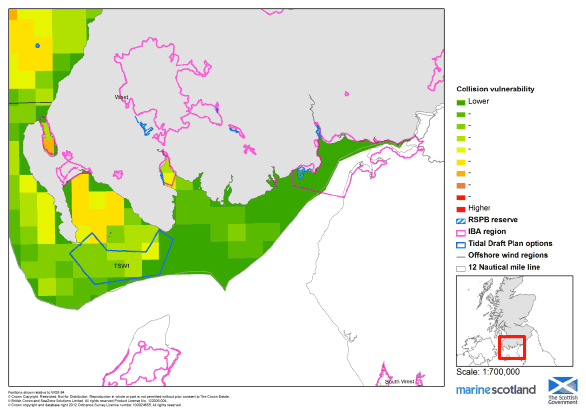
Figure B1.2.64: Seabird Collision Vulnerability from Tidal Energy in the South West (Winter Season)
Seabird collision vulnerability. Tidal Energy. South West area (Winter season)
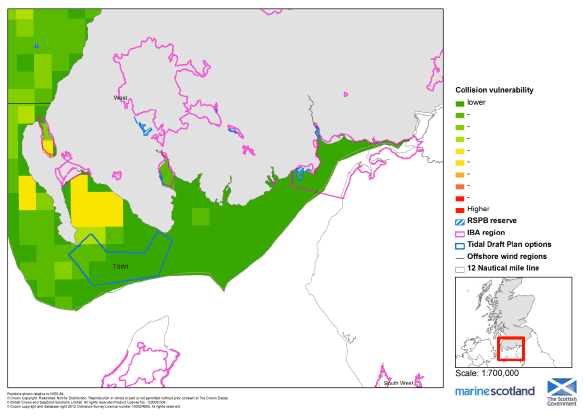
Contact
There is a problem
Thanks for your feedback